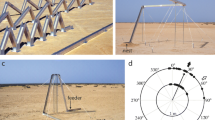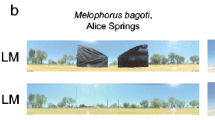Abstract
Desert ants, Cataglyphis fortis, navigate individually in the salt pans of Tunisia by means of path integration. However, as path integration is error-prone, the ants in addition use visual and olfactory cues to pinpoint their nest entrance. It has been shown that the accuracy of the path integrator as well as the ants’ confidence in that egocentric navigational tool decreases with increasing foraging distance. Here, we show that despite the accumulating errors, even after far-reaching foraging runs path integration provides the ants with surprisingly accurate information regarding the nest position. However, in addition, the ants take into account distant visual cues that are most probably provided by the patterns along the horizon line behind the nest entrance.



Similar content being viewed by others
References
Beugnon G, Lachaud JP, Chagné P (2005) Use of long-term vector information in the neotropical ant Gigantiops destructor. J Insect Behav 18:415–432
Bregy P, Sommer S, Wehner R (2008) Nest-mark orientation versus vector navigation in desert ants. J Exp Biol 211:1868–1873
Buehlmann C, Cheng K, Wehner R (2011) Vector-based and landmark guided navigation in desert ants inhabiting landmark-free and landmark-rich environments. J Exp Biol 214:2845–2853
Buehlmann C, Hansson BS, Knaden M (2012) Path integration controls nest-plume following in desert ants. Curr Biol 22:645–649
Buehlmann C, Graham P, Hansson BS, Knaden M (2014) Desert ants locate food by combining high sensitivity to food odors with extensive crosswind runs. Curr Biol 24:960–964
Cartwright BA, Collett TS (1983) Landmark learning in bees—experiments and models. J Comp Physiol A 151:521–543
Cheng K, Middleton EJT, Wehner R (2012) Vector-based and landmark-guided navigation in desert ants of the same species inhabiting landmark-free and landmark-rich environments. J Exp Biol 215:3169–3174
Cheung A, Vickerstaff R (2010) Finding the way with a noisy brain. PLoS Comput Biol 6:e1000992
Cheung A, Hiby L, Narendra A (2012) Ant navigation: fractional use of the home vector. PLoS One 7(11):e50451
Collett M (2010) How desert ants use a visual landmark for guidance along a habitual route. Proc Natl Acad Sci USA 107:11638–11643
Collett M (2012) How navigational guidance systems are combined in a desert ant. Curr Biol 22:927–932
Fukushi T (2001) Homing in wood ants, Formica japonica: use of the skyline panorama. J Exp Biol 204:2063–2072
Knaden M, Wehner R (2005) Nest mark orientation in desert ants Cataglyphis: what does it do to the path integrator? Anim Behav 70:1349–1354
Merkle T, Wehner R (2009) Repeated training does not improve the path integrator in desert ants. Behav Ecol Sociobiol 63:391–402
Merkle T, Wehner R (2010) Desert ants use foraging distance to adapt the nest search to the uncertainty of the path integrator. Behav Ecol 21:349–355
Merkle T, Knaden M, Wehner R (2006) Uncertainty about nest position influences systematic search strategies in desert ants. J Exp Biol 209:3545–3549
Müller M, Wehner R (1988) Path integration in desert ants, Cataglyphis fortis. Proc Natl Acad Sci USA 85:5287–5290
Müller M, Wehner R (1994) The hidden spiral: systematic search and path integration in desert ants, Cataglyphis fortis. J Comp Physiol A 175:525–530
Müller M, Wehner R (2007) Wind and sky as compass cues in desert ant navigation. Naturwissenschaften 94:589–594
Narendra A (2007a) Homing strategies of the Australian desert ant Melophorus bagoti I. Proportional path-integration takes the ant half-way home. J Exp Biol 210:1798–1803
Narendra A (2007b) Homing strategies of the Australian desert ant Melophorus bagoti II. Interaction of the path integrator with visual cue information. J Exp Biol 210:1804–1812
Narendra A, Gourmaud S, Zeil J (2013) Mapping the navigational knowledge of individually foraging ants Myrmecia croslandi. Proc R Soc Lond B Biol 280:20130683
Sommer S, Wehner R (2004) The ant’s estimation of distance travelled: experiments with desert ants, Cataglyphis fortis. J Comp Physiol A 190:1–6
Steck K, Hansson BS, Knaden M (2009) Smells like home: desert ants, Cataglyphis fortis, use olfactory landmarks to pinpoint the nest. Front Zool 6:5
Vickerstaff R, Cheung A (2010) Which coordinate system for modelling path integration? J Theor Biol 263:242–261
Wehner R (1987) Spatial organization of foraging behavior in individually searching desert ants, Cataglyphis (Sahara Desert) and Ocymyrmex (Namib Desert). Exp Suppl 54:15–42
Wehner R (2003) Desert ant navigation: how miniature brains solve complex tasks. J Comp Physiol A 189:579–588
Wehner R (2009) The architecture of the desert ant’s navigational toolkit (Hymenoptera: Formicidae). Myrmecol News 12:85–96
Wehner R, Müller M (2006) The significance of direct sunlight and polarized skylight in the ant’s celestial system of navigation. Proc Natl Acad Sci USA 103:12575–12579
Wehner R, Srinivasan MV (1981) Searching behavior of desert ants, Genus Cataglyphis (Formicidae, Hymenoptera). J Comp Physiol 142:315–338
Wehner R, Michel B, Antonsen P (1996) Visual navigation in insects: coupling of egocentric and geocentric information. J Exp Biol 199:129–140
Wittlinger M, Wehner R, Wolf H (2006) The ant odometer: stepping on stilts and stumps. Science 312:1965–1967
Wittlinger M, Wehner R, Wolf H (2007) The desert ant odometer: a stride integrator that accounts for stride length and walking speed. J Exp Biol 210:198–207
Wystrach A, Beugnon G, Cheng K (2011) Landmarks or panoramas: what do navigating ants attend to for guidance? Front Zool 8:21
Wystrach A, Mangan M, Philippides A, Graham P (2012) Snapshots in ants? New interpretations of paradigmatic experiments. J Exp Biol 216:1766–1770
Acknowledgments
This study is dedicated to Ruediger Wehner, without whom we never would have got in contact with the fascinating desert ant Catagylphis. The study was financed by the Max Planck Society. We thank Katharina Franke for assistance during the field experiments and Alexander Warmbold and Dieter Kaiser for help with the computational analyses and the MATLAB programming.
Conflict of interest
The authors declare that they have no conflict of interest.
Ethical standard
The international, national, and/or institutional guidelines for the care and use of animals have been followed.
Author information
Authors and Affiliations
Corresponding author
Electronic supplementary material
Below is the link to the electronic supplementary material.
Rights and permissions
About this article
Cite this article
Huber, R., Knaden, M. Egocentric and geocentric navigation during extremely long foraging paths of desert ants. J Comp Physiol A 201, 609–616 (2015). https://doi.org/10.1007/s00359-015-0998-3
Received:
Revised:
Accepted:
Published:
Issue Date:
DOI: https://doi.org/10.1007/s00359-015-0998-3




